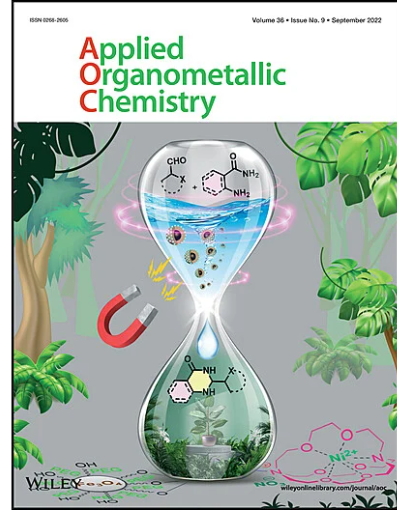蜂胶纳米银抗炎抗氧化性能的合成与GC-MS分析
摘要
本研究以蜂胶水溶液提取物为生物还原剂制备其银纳米粒子(Prop-AgNPs)。首先,对提取液进行GC-MS分析,确定其化学成分。鉴定后,将Prop-AgNPs与亲本原始提取物进行比较,评估其生物学潜力。扫描电镜显示NPs呈球形或半球形,粒径分布在80 ~ 100 nm之间。结果表明,该提取物和制备的纳米颗粒对DPPH自由基的IC50值分别为55.07和46.62 μg/mL,而对标准抗坏血酸的IC50值为30.35 μg/mL。然后在动物模型中评估Prop-AgNPs的体内抗炎能力。采用松节油诱导大鼠下肢炎症反应,观察其生化和血液学指标的变化。给药14 d,分别给予提取物和Prop-AgNPs,在第7天和第14天监测生化指标。相比之下,在研究的第14天,结果更有希望。正常组第7天和第14天肌酐分别为0.55±0.08和0.50±0.04,阴性对照组分别为0.88±0.04 (p < 0.001)和0.94±0.03;标准组记录值分别为0.57±0.09和0.53±0.07。0.5和1 mg/kg体重(b.w.)剂量组第7天肌酐水平分别为0.78±0.23 (p < 0.05)和0.69±0.13,第14天肌酐水平分别为0.69±0.13和0.65±1.15。0.5 mg和1 mg/kg b.w.组第7天肌酐水平分别为0.76±0.03和0.63±0.09,第14天肌酐水平分别为0.71±0.09和0.60±0.05。与正常对照组和阴性对照组相比,提取物和Prop-AgNPs均使血尿素、SGPT、胆红素和碱性磷酸酶水平正常化,其中血尿素、SGPT和碱性磷酸酶的结果具有统计学意义(p < 0.001)。正常对照组、阴性对照组和标准组第7天的血红蛋白水平分别为10.4±0.13、12.5±0.68 (p < 0.001)和12.4±0.43 (p < 0.001),而第14天的血红蛋白水平分别为12.1±00.52、13.8±0.57 (p < 0.001)和12.6±0.54,表明研究参数的变化更有希望。蜂胶提取物0.5和1 mg/kg b.w.组第7天血红蛋白水平分别为11.9±0.27 (p < 0.001)和11.8±0.31 (p < 0.001),第14天血红蛋白水平分别为12.9±0.24和12.8±0.54,而纳米颗粒等剂量组第7天血红蛋白水平分别为11.8±0.38 (p < 0.001)和12.7±0.41 (p < 0.001)和13.9±0.34和12.2±0.74 (p < 0.001)。同样,中性粒细胞、淋巴细胞、单核细胞和嗜酸性粒细胞的水平在纳米颗粒处理组中具有统计学意义(p < 0.001)。本研究发现Prop-AgNPs通过改善/逆转生化和血液学参数的变化对松节油诱导的炎症有积极影响,这表明其抗炎潜力可用于药物配方。

In the current study, propolis aqueous extract was utilized as biological reducing agent to fabricate its silver nanoparticles (Prop-AgNPs). First, the extract was subjected to GC–MS analysis to determine its chemical profile. After characterization, the Prop-AgNPs were evaluated for its biological potential in comparison with parental raw extract. The SEM images revealed the NPs as spherical or somewhat spherical in shape with particle size distribution ranging from 80 to 100 nm. The antioxidant potentials of the extract and fabricated nanoparticles were determined against DPPH free radical producing substantial antioxidant activities with IC50 values of 55.07 and 46.62 μg/mL correspondingly, whereas for standard ascorbic acid, its value recorded was 30.35 μg/mL. The Prop-AgNPs was then evaluated for in vivo anti-inflammatory potentials in animal model. Inflammation was induced by administering turpentine oil to lower limb of rat, and subsequently, changes in biochemical and hematological parameters were monitored. Animals were administered with doses of extract and Prop-AgNPs for 14 days, whereas biochemical parameters were monitored at day 7th and 14th of the study. Comparatively, the results were more promising on day 14th of the study. The creatinine level for the normal group were 0.55 ± 0.08 and 0.50 ± 0.04 at day 7th and 14th, whereas for negative control group, the results were 0.88 ± 0.04 (p < 0.001) and 0.94 ± 0.03 correspondingly; while for standard group, the recorded values were 0.57 ± 0.09 and 0.53 ± 0.07. Groups treated with 0.5 and 1 mg/kg body weight (b.w.) doses of extract has creatinine level 0.78 ± 0.23 (p < 0.05) and 0.69 ± 0.13 at day 7th while 0.69 ± 0.13 and 0.65 ± 1.15 at day 14th. Group treated with dose of 0.5 mg and 1 mg/kg b.w. of the synthesized nanoparticle has creatinine level 0.76 ± 0.03 and 0.63 ± 0.09 at day 7th while 0.71 ± 0.09 and 0.60 ± 0.05 at day 14th of the study. Both the extract and Prop-AgNPs normalized the level of blood urea, SGPT, bilirubin, and alkaline phosphatase compared with normal control and negative control groups among which the results of blood urea, SGPT, and alkaline phosphatase were statistically significant (p < 0.001). The level of hemoglobin for the normal control, negative control, and standard groups was 10.4 ± 0.13, 12.5 ± 0.68 (p < 0.001) and 12.4 ± 0.43 (p < 0.001) at day 7th, whereas at day 14th, the results were 12.1 ± 00.52, 13.8 ± 0.57 (p < 0.001), and 12.6 ± 0.54 indicated more promising changes the studied parameter. The group treated with 0.5 and 1 mg/kg b.w. doses of propolis extract has hemoglobin levels 11.9 ± 0.27 (p < 0.001) and 11.8 ± 0.31 (p < 0.001) at day 7th, whereas at day 14th, the results were 12.9 ± 0.24, and 12.8 ± 0.54 while equivalent doses of nanoparticles resulted in hemoglobin level as 11.8 ± 0.38 (p < 0.001) and 12.7 ± 0.41 (at day 7th) and 13.9 ± 0.34 and 12.2 ± 0.74 (at day 14th). Similarly, levels of neutrophils, lymphocytes, monocytes, and eosinophils were statistically more significant (p < 0.001) for nanoparticles treated groups. This study found positive impact of Prop-AgNPs on inflammation induced by turpentine oil by improving/reversing changes brought in biochemical and hematological parameters pointing toward its anti-inflammatory potential that could be utilized in drug formulation.

 求助内容:
求助内容: 应助结果提醒方式:
应助结果提醒方式:


